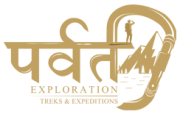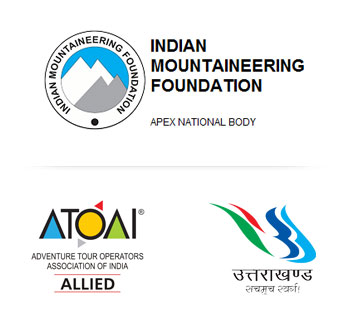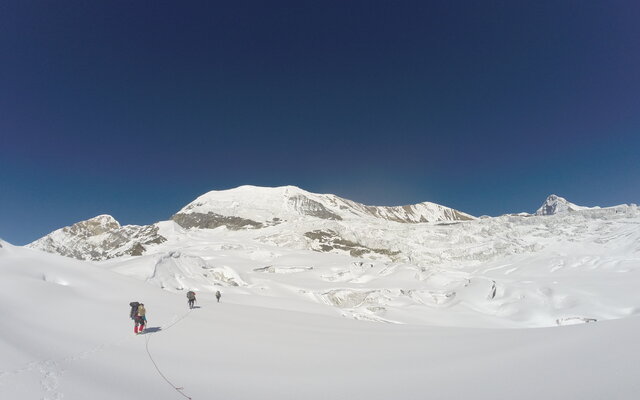
Level: Technical
TRAILLS PASS (PINDARI KANDA) (5312 M)
- 16 Days
- Post-monsoon
Fixed Departure:
Post Monsoon Dates :
- 01 September 2024
- 58000/-
Send Your Requirement:
Brief Description
In the18th Century this pass was the trade route for trading with Tibet. But with the passage of time this route was abandoned for its difficulties. This challenging Himalayan pass was named after George William Traill, the 2nd British Commissioner of Kumaon (1816-1836), showed interest to reopen this route.. As Everest was named after George Everest, the illustrious Surveyor-General of India (1830-1843). A comparison between the two, though not relevant, is interesting. Both Georges earned the distinction sometime after relinquishing their posts and even the legend of Radhanath Sikdar related to the discovery of Everest has a parallel. Both Traill and Everest began service in India with the East India Company about the first decade of the 19th Century.
People from Johar Valley and Pindar Valley traced to cross it for trade. Budha Malak Singh of Supi village of Bageshwar District of Uttarakhand State was the first man to cross it 1830 after 100 years. Later Mr. Traill also attempted to cross the pass but failed, though the pass was since then named as TRAILL’s Pass, earlier it was called “Pindari Kanda”. Traill’s Pass (el. 5,312 m) is a mountain pass through the Himalayas located between the unnamed southern shoulder Mt. Nanda Devi East and Changuch (Western shoulder of Mt.Nanda Kot) peaks of the Uttarakhand state in the districts of Bageshwar and Pithoragarh. It is situated on the head of Pindari glacier and Trails pass bridges Pindari Valley with LwanValley (Nandadevi East Base camp) and said to be very difficult to cross. Though Pindari glacier is visited by many people every year, yet Traill’s Pass, which is at its top remains an elusive goal.
By Himalayan standards, the Pindari glacier and the Traill’s Pass do not match most of the giants. The Pindari is neither the largest nor the longest of the glaciers nor is the Traill’s Pass, at its head, the highest of passes. However, Pindari has been the most frequently visited Himalayan glacier since the mid-19th century when a bridle-path with dak bungalows at suitable intervals between there and Almora was built. Even today, it is so popular a trekking destination that a tenfold increase in the number of beds available is unable to cope with the influx.
What faces a visitor to Pindari glacier at the Zero Point, along its left lateral moraine, is an immense wall of jagged, broken ice criss¬crossed with thousands of seracs and crevasses. The upper icefields of the glacier are invisible from there and the near level ice mass at its lower end at the snout below recedes into insignificance. What people call the Pindari glacier is actually a huge icefall passing over a steep slope, through which a direct ascent has yet to be made. Above this lie the icefields of the surrounding heights and the névé basin of the glacier, some 8 kms long, separated from the ridge above with a text-book fashion bergschrund. The lowest point on the ridge at 5312 m is the Traill’s Pass. Beyond the pass to the north and east lies the Lwan valley whose catchment is the Gori ganga valley.
Pindar river which forms the main tributary of river Alaknanda further joins the Bhagirathi to form The Ganges at Dev Prayag.
Highlights and Key Features
Technical Detail
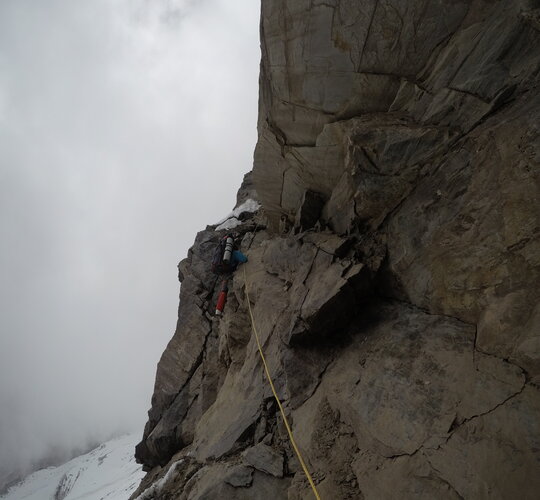
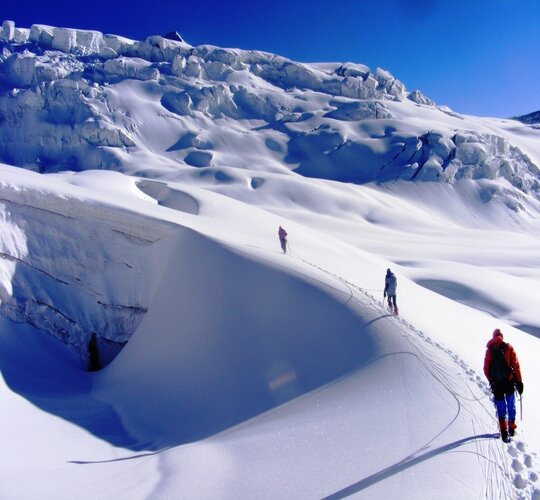

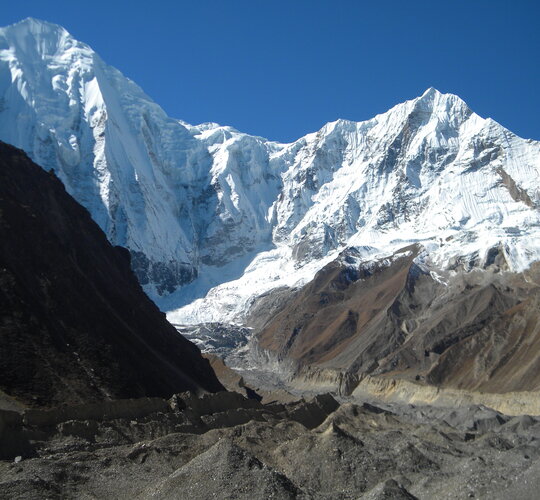
Itinerary
Day 1 : Arrival at Kathgodam in the morning & move to Bageshwar.
Overnight stay in lodge at Bageshwar.• 165 kms , 5 hrs drive
Day 2 : Transfer Bageshwar to Kharkiya Road head(R.H.) by jeeps & trek to Khati Village.
• 80kms approx. 4 hrs drive, 1 hrs 40 mins walk to Khati Village.
Day 3 : Khati village to Dwali
• 6 hrs trek
Day 4 : Dwali to Pindari glacier base camp
• 6-7 hrs
Day 5 : Acclimatization walk around base camp
Day 6 : Base camp to Takhta camp & back to base camp / Load ferry
Day 7 : Move to Advance base camp / Takhta camp
Day 8 : Trek & ferry to Wall base camp & back to Advance Base camp
• 5-6 hrs
Day 9 : Climbing 200 meters wall & fixing of ropes
• 7-8 hrs
Day 10 : Occupation of camp one above wall
• 5-6 hrs
Day 11 : Crossing of Traills pass and camping at Nanda Devi East base camp
• 7 hrs
Day 12 : Nanda devi east base camp to Naspanpatti / Ratagangal camp Contingency day
• 6-7 hrs
Day 13 : Camping at Martoli village
• 5-6 hrs
Day 14 : Martoli to Baglidhar camp
• 6-7 hrs
Day 15 : Baglidhar to Chilamdhar (R.H.) Munsyari
• 4-5 hrs
Day 16 : Munsyari to Kathgodam & Dispersal
• 10-12 hrs drive
Inclusion & Exclusion
Inclusion
- Meals during the trek: Coverage from dinner on Day 1 to Breakfast on Day 16 ensures participants are provided with necessary sustenance throughout the trek.
- Forest Permits/Camping Charges: covering permits and charges for camping in the designated forest areas.
- Accommodation: 4 Season Tents on a triple-sharing basis, Thermal rated sleeping bags, and mats are provided for a comfortable and restful night’s sleep. Guest house/lodge stays in Bageshwar on Day 1& in Munsiyari on day 15 are also included.
- Support Staff: Experienced trek guides, cooks, helpers, and mules or porters are included for carrying common supplies, facilitating a smoother trekking experience.
- Expedition Leader: A IMF approved Expedition Leader.
- Transportation: Kathgodam to Bageshwar & Munsiyari to Kathgodam Transport included.
- Technical Equipment – PP Ropes, Helmet, Ice Axe, Crampons, Mountaineering Boots, Snow Stake, Dead Man/Boy
- Peak Booking Fee Charges (upto the amount charged for Indian nationals)
Exclusion
- Portage of Personal Bags: The cost of portaging personal bags during the trek is not included and may be an additional expense for participants.
- Travel Insurance: The cost of any kind of travel insurance is not covered, and participants are advised to arrange their own travel insurance for additional protection.
- Personal Expenses: Any expense of a personal nature, such as additional meals, snacks, or personal items, is not included.
- Unspecified Expenses: Any expense not explicitly specified in the inclusions list is not covered and may be the responsibility of the participants.
- Any extra costs incurred in the event of finishing the expedition early
- Expenses of a personal nature like laundry, phone calls, and beverages.
- Tips for local guides or porter
- IMF Peak Booking Fee for foreign nationals US$ 700 for a team of two members and US$ 325 for every additional participants
- Forest Permit / Camping Fee for foreign nationals (USD 880-1000 upto group of 10)
- Mandatory Liaison Officer Fee for foreign expeditions ( ~USD 500 for group of 10)
- Any cost arising out of unforeseen circumstances such as bad weather, landslides, road conditions and any other circumstances beyond our control.
Things to Carry
When embarking on a mountaineering expedition, it’s crucial to carry the right gear and equipment to ensure your safety, comfort, and success in the challenging mountain environment. Here’s a comprehensive list of things to carry for a mountaineering expedition:
1. Clothing:
• Base layers (moisture-wicking)
• Insulating layers (fleece or down jackets)
• Waterproof and windproof outer layers (jacket and pants)
• Hardshell or Gore-Tex jacket for extreme weather conditions
• Mountaineering boots ( We provide)
• Gaiters to keep snow out of boots ( We provide)
• Climbing harness ( We provide)
• Crampons for icy terrain ( We provide)
• Gloves (waterproof and insulated)
• Warm hat and balaclava
2. Navigation and Communication (Optional):
• Map and compass
• GPS device
3. Safety and First Aid:
• First aid kit with essentials
• High-altitude sickness medication
• Prescription medications (if needed)
• Sunscreen with high SPF
• Sunglasses with UV protection
• Lip balm with UV protection
• Headlamp or flashlight with extra batteries
• Repair kit for gear
4. Climbing Accessories:
• Mountaineering backpack with sufficient capacity
• Trekking poles
• Climbing gloves
5. Personal Items:
• Personal identification and relevant permits
• Cash and credit cards
• Camera for documenting the journey
• Personal toiletries and hygiene items
• Notebook and pen
6. Food and Nutrition:
• High-energy snacks (energy bars, nuts, dried fruits)
• Electrolyte tablets or sports drinks
• Water bottles or hydration system
7. Miscellaneous:
• Duct tape
• Multi-purpose tool or knife
• Compact shovel for snow conditions
• Whistle
• Trash bags for waste disposal
8. Documentation:
• Expedition itinerary and permits
• Emergency contact information
• Insurance details
Also, ensure that your gear is in excellent condition and properly maintained.
Why Us
Parvat Exploration: Your Trusted Himalayan Guides
Embark on an unforgettable adventure with Parvat Exploration – where expertise meets passion. Here’s why choosing us for your trek is the key to an extraordinary Himalayan experience:
1. Highly Qualified Team, Seasoned in Indian Mountaineering: Join a team of seasoned mountaineers with a wealth of experience navigating the challenging terrains of the Indian Himalayas. Our expertise is your assurance of a trek that combines adventure with safety and knowledge.
2. Exclusive IMF Associate Membership: Trust your journey with the best, as three of our team members hold an esteemed position as associate members with the Indian Mountaineering Foundation (IMF). This exclusive membership is limited to only 100 individuals in India, highlighting the caliber and dedication of our team.
3. Local Expertise – Meet Team Parvat Exploration, a Himalayan Native: A proud local born and raised in Uttarakhand. The Himalayas are not just our workplace; they are our home. With Team Parvat Exploration as your guide, you’ll experience the mountains through the eyes of someone deeply connected to its culture, people, and nuances.
4. Accredited by ATOAI, IMF & Uttarakhand Tourism: Parvat Exploration proudly stands as an affiliated firm with the Adventure Tour Operators Association of India (ATOAI), the Indian Mountaineering Foundation (IMF), and Uttarakhand Tourism. Our triple accreditation underscores our commitment to responsible and high-quality trekking adventures.
5.Safety is Our Pledge: Your safety is our topmost priority. At Parvat Exploration, safety isn’t just a priority; it’s a fundamental principle that guides every aspect of our treks. Rest assured, you’re in capable hands as we navigate the trails with your well-being as our foremost concern.
6. World-Class Equipment: Equip yourself with the best, as we provide world-class gear. Our equipment is meticulously maintained and regularly updated to meet the highest industry standards, ensuring your comfort and safety throughout the trek.
7. Delicious and Nutritious Food with Local Delicacies: Savor the journey with our culinary delights. Our team takes pride in offering not just nourishing meals but also a variety of options, including delicious and nutritious local dishes. Immerse yourself in the rich flavors of the region as you trek through the breathtaking landscapes.
8. Expert Trek Leaders – AMC Qualified: Our trek leaders are not just leaders; they are minimum AMC qualified from recognized institutes. This ensures that you are guided by professionals who understand the nuances of mountain terrain and are well-prepared for any challenges that may arise.
9. Seasonal Specialization – All Year Adventure: Parvat Exploration specializes in mountaineering during the prime season and offers captivating winter treks. Whether you’re drawn to the thrill of summer ascents or the serene beauty of winter landscapes, we have the expertise to make your trek extraordinary, regardless of the season.
Choose Parvat Exploration for a trek that transcends the ordinary. Your Himalayan adventure awaits, crafted with expertise, passion, and a commitment to making your journey truly exceptional.
